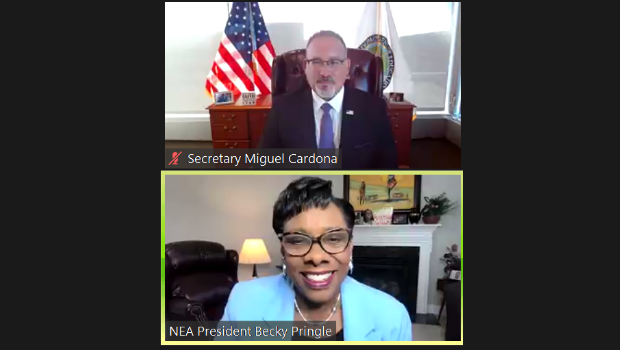I’m unsure what changes have been made in my school to improve air quality and ventilation. Where do I turn?
What’s the latest COVID guidance from the CDC on protecting immunocompromised students and educators?
What’s up with the new vaccine the FDA announced this week?
We’ve seen so many inequities during the pandemic affecting communities of color. What are school districts required to do to mitigate, and what are best practices?
We keep hearing about accelerating students’ learning. Over the next few months, what does that look like?
As educators begin the 2022-2023 school year, these and other questions about ensuring safe, healthy, and effective learning environments are top of mind.
A September 1 virtual town hall meeting with White House COVID Response Coordinator Ashish Jha, U.S. Secretary of Education Miguel Cardona, CDC Director Rochelle Walensky, and U.S. Secretary of Health and Human Services Xavier Becerra helped answer many of those questions. Co-hosted by NEA President Becky Pringle and AFT President Randi Weingarten, the town hall explored issues related to students’ mental health, COVID prevention, and the nation’s alarming teacher burnout and shortage, among other topics.
“We cannot ignore the challenges we all face—COVID, gun violence, mental health issues, the startling educator shortage,” Pringle said, adding that NEA has put together a series of resources to advocate for student health, school safety, and more. (Find them at nea.org/healthyschools.)
“To our members listening right now, this is really important,” said Weingarten. “This is a year that we’re trying not only to bring normalcy but also help children thrive—and this administration is helping us. Educators have been there for our students academically, socially, and emotionally. They have MacGyvered better than MacGyver these last few years. But they also need our support.”
Calling NEA and AFT “intentional partners and collaborators in the effort to keep schools safely open,” Cardona commended the nation’s educators for lifting up our country.
“Thank you for always putting your students first,” he said. “You’ve been challenged in ways you would have never imagined. But it’s time for a fresh start, and time to build on progress. We have a lot to do.”
New normal—not ‘back to normal’
Describing President Biden’s American Rescue Plan as an unprecedented resource to support students’ mental health, Cardona emphasized the need to put those dollars to work.
“We must unapologetically challenge—and not normalize—ratios such as 500 students to one school social worker or counselor. Our educational workforce and students need support. We need our local board policies and state policies to view mental health access as a basic need. Some schools get it. Some have done things like create a dedicated period in the school schedule for mental health to keep students healthy, engaged, and thriving this year and beyond.”
Cardona called for districts to commit more resources—especially with the influx of federal funding—to hiring and, importantly, retaining educators.
“We must support all of you—our educators who are doing the hard work—by elevating the profession.
 “The teacher shortage issue is a byproduct of the teacher respect issue. I call this the ABC’s: teachers need agency, and better salaries, and good working conditions.”
“The teacher shortage issue is a byproduct of the teacher respect issue. I call this the ABC’s: teachers need agency, and better salaries, and good working conditions.”
In a surprise special address to educators participating in the virtual town hall, First Lady Dr. Jill Biden—an educator herself—acknowledged, “This job isn’t easy, and there are times when we are going to feel tired and frustrated. But I hope in those moments you can hold onto the sense of possibility that so many of us feel right now. What you do matters—to your students, to your communities, to all of us. Never forget that you are changing lives, and that you are guiding the next generation.”
The crisis continues
The town hall’s health and education experts acknowledged that the pandemic is not over, that its impact has varied widely among individuals and communities, and that it has uncovered and exacerbated everything from health inequities to mental health crises.
Becerra noted, for example, that more than 40% of teens today report struggling with mental health.
“This is real, and COVID has made it worse,” he said. Tens of millions of grant dollars, he pointed out, are earmarked for addressing the youth mental health crisis, with additional funding sources available to schools.
“Though we’ve all been in this together, and the pandemic has affected all of us,” Jha added, “it has not affected all of us equally. We can’t just make treatments available and walk away. We must provide trusted voices to answer questions and open up access.”
Calling vaccines the cornerstone of keeping children and staff safe, Jha also stressed the critical role of proper ventilation and air circulation in schools.
“Air quality has a direct impact on student learning,” he said. “We all do better when we breathe clean air, and we have the tools to keep students in school and safe learning all year.”
Walensky reiterated the need to optimize ventilation. An interactive tool on the CDC’s website, she said, can help schools calculate what that looks like.
Knowing that they have worked through the pandemic largely without a roadmap, Walensky told educators, “You have my heartfelt gratitude for your innovation and resilience, the way you have successfully navigated how you teach, kept students safe, and created environments where students feel connected in school.”







